Click image for BBB rating
See our Privacy Policy
cool="cool" width="784" height="9107" border="0" cellpadding="0" cellspacing="0" gridx="16" showgridx="showgridx" usegridx="usegridx" gridy="16" showgridy="showgridy" usegridy="usegridy" bgcolor="#99ccff">
|
|
|
 |
|
|
|
|
|
|
Welcome to Spaightwood Galleries, Inc.
120 Main Street, Upton MA 01568-6193
You can follow us on Facebook and Twitter!
We blog regularly on Facebook and announce special events and special sales on both sites.
Old Master Prints: Albrecht Durer (Nuremburg, 1471-1528), The Small Woodcut Passion II
|
|
|
|
|
|
According to Walter Strauss (Albrecht Durer Woodcuts and Wood Blocks [NY: Abaris Books, 1980], p. 342 and after), Durer may have begun the the Small Woodcut Passion as early as 1502 or 1503, though most of the woodcuts proabably date to 1508-1510. It was completed in 1510 and published it in 1511 with Latin verses by Benedictus Chelidonius facing each plate. Some trial proofs before the first edition exist and impressions were printed from Dürer's original woodblocks up until 1612, when an Italian edition was printed from Dürer's original woodblocks. There are thirty-seven woodcuts in the series, beginning The Fall of Man and concluding with The Last Judgment. While only a few of the plates are dated, those that are suggest that Durer originally began with Christ's Entry into Jerusalem on Palm Sunday and concluded with The Last Judgment. As he was completing the series c. 1510, however, he added The Fall of Man, The Expulsion from Eden (dated 1510), The Annunciation, The Nativity, and Saints Peter, Paul, and Veronica holding the Suderium (dated 1510). These additions change the focus from a history of The Passion to a history of mankind with Adam and Eve as the source of man's woes and Jesus as man's salvation. Of all of Durer's great works in series, the Small Woodcut Passion is by far the largest. It was also one of his most popular: it was reprinted several times up to an Italian edition of 1612. Although there exist later impressions printed from Durer's original blocks, they are gray and blotchy and do not print well. In addition to the prints made from Durer's woodblocks and the copies by Marantonio Raimondi (engravings published in Venice in the early 16th century), Virgil Solis (published in Nurenberg in the late 16th century with Solis' monogram VS, and a set of very deceptive copies by Mommard published a bit later, there exists as well a set made in the 19th century from metal plates made from plaster casts of thirty-five of Durer's original woodblocks after they were given to the British Museum in 1839. In 1844 Henry Cole of the South Kensington Museum (now the Victoria and Albert Museum) published his edition of the the Durer Small Passion woodcuts and described the process by which they were made:
"The present work, with the exception of two subjects, is taken from the original engravings drawn by Albrecht Durer himself on the wood, and engraved under his own superintendence. [The consensus is that Durer cut the blocks himself for his early works including The Ship of Fools until he could train professional woodcutters to reach the level he had achieved, worlds beyond anything anyone had done up to that time in terms of subtlety, fineness of line, density, etc.] . . . [T]he present, it is believed makes the fourth edition of the genuine blocks. I say genuine blocks, for so great was the popularity and estimation of the work, that there has been more than one obvious imitation of them, besides several avowed copies constantly circulating throughout Europe. The Small Passion is stated by all writers on the subject . . . to have originally consisted of thirty-seven subjects. . . . [He then distinguishes two lifetime editions of the complete work, as opposed to individual printings of individual works that Durer sold or gave away when he traveled]. The third edition of the genuine woodcuts was published at Venice, in 1612, by a Librarian who, according to Heinecke, purchased them in the Netherlands. . . . The engravings republished in the present volumes are from the same blocks. Thirty-five of the thirty-seven of them have found a secure resting place in the British Museum. They were purchased in 1839 by Mr. Josi, the present keeper of the prints, from the Rev. P. E. Boissier, whose father bought them many years ago in Italy. . . . The four impressions of these blocks which were printed by Mr. Otley in his History of Engraving, (p. 730) show the extent of the damage which the blocks have suffered. But in the present edition of them, the defects have been remedied by using stereotype casts of the blocks, which have been taken by a special permission of the trustees of the British Museum [that would never have happened in this century!]. New border lines have been added, the worm-holes stopped, and those parts skillfully recut by Mr. Thurston Thompson, who has also re-engraved with full feeling, the subjects of the Sitting Christ and of Jesus Parting from his Mother. The process of stereotyping has had the good effect of restoring almost the original sharpness and crispness of the lines, and of rendering the present impressions nearer the state of the earliest impressions than they would have been had they been taken from the blocks themselves. This statement may seem paradoxical, but it will be seen that it has a reasonable explanation. In order to take a metal cast of a woodcut, a cast is first taken in moist plaster of Paris. This is thoroughly dried by baking, which causes it to shrink throughout, sometimes as much as the eighth of an inch in a cast of six inches in length. The result of this slight shrinkage has been to reduce these thickened lines nearly to their original fineness, and several of the present impressions are so crisp and clear that they will not suffer by comparison with choice early impressions."
We offer a selection if impressions ranging from Durer's first edition lifetime proofs to later editions and include some of the 1844 impressions as well.
Select bibliography: Walter L. Strauss in his catalogue raisonne, Albrecht Durer Woodcuts and Woodblocks (Abaris Books, 1980), provides a summary of comments upon each individaul work. Strauss' Commentary volume in the Illustrated Bartsch series updates his earlier commentary and gives details on copies of Dürer's prints. As always, Panofsky's Life and Art of Albrecht Durer (Princeton University Press, 1943, revised editions all preserving the original pagination) is crucial for an understanding of the work of this great artist and printmaker. The "Handlist" in volume 2 of the 1943, 1945, and 1948 editions of Panofsky's magnum opus contains entries on many of the works in the series; unfortunately, editions of the one-volume edition from 1955 onward do not include the Handlist.
|
|
|
|
|
|
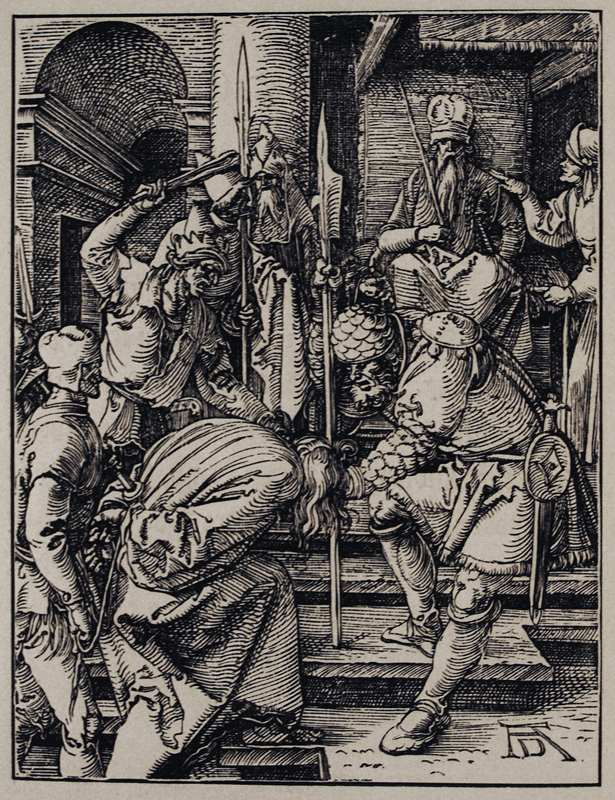 |
|
|
|
|
Christ before Annas (B. 28, S. 113, Meder 137). Original woodcut, c. 1508-09. Strauss points out that this subject is unique to The Small Passion and is not included in any of Dürer's other versions of The Passion. Strauss also suggests that in picturing four 'presentations' in The Small Passion, Dürer follws the tradition pf Passion plays, where Christ is invariably taken before Annas, Caisphas, Pilate, and Herod, in this order. In 1844 plaster casts were made from Dürer's original woodblocks for the Small Woodcut Passion, which had just been acquired by the British Museum. From these casts, metal plates were made and a small edition produced. Our impression is from this edition. Image size: 127x95mm. Price: Please call or email for current pricing information.
|
|
|
|
|
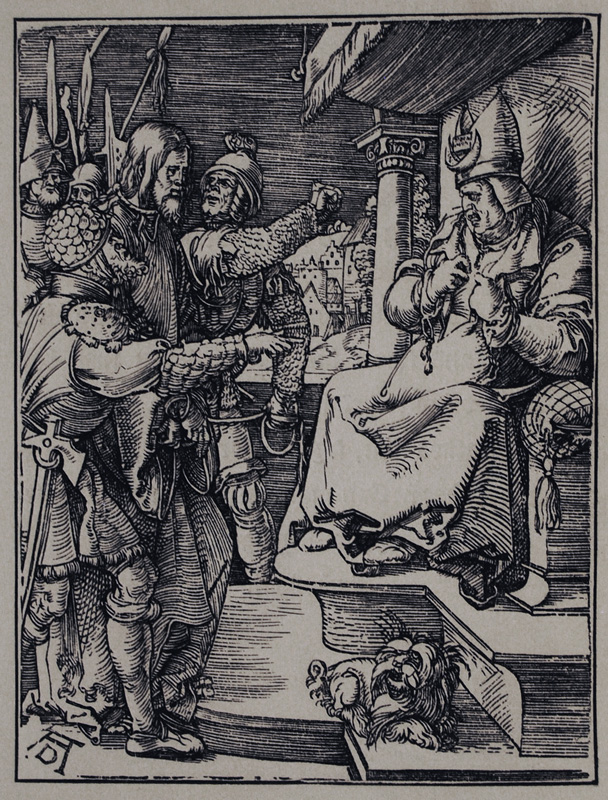 |
|
Christ before Caiaphas (B. 29, S. 114, Meder 138). Original woodcut, c. 1508-09. Strauss notes that Caiaphas, the high priest who had prophesied that Christ would die for his people (John 11:51), here is shown tearing his clothes in feigned indignation upon learning of Christ's "blaspemy" by having answered in the affirmative that he was indeed the Son of God (Matthew 26:65; Mark 14:63; Luke 22:71)." Strauss also notes that Caiaphas's theatrics are chief focus of Dürer's presntation. Heller notes that copies of this scene exist by Master GS, Marcantonio Raimondi, Virgil Solis, Mommard, Waesberg, and others. In 1844 plaster casts were made from Dürer's original woodblocks for the Small Woodcut Passion, which had just been acquired by the British Museum. From these casts, metal plates were made and a small edition produced. Our impression is from this edition. Image size: 127x97mm. Price: Please call or email for current pricing information.
|
|
|
|
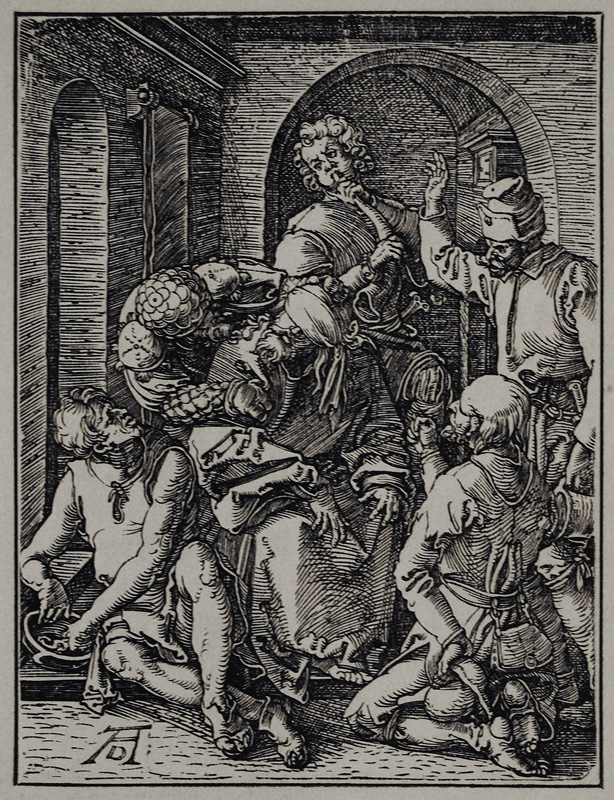 |
|
The Mocking of Christ (B. 30, S. 115, Meder 139). Original woodcut, c. 1508-09. Strauss points out that here follows Mark 14:65: "And some began to spit on him, and to cover his face, and to buffet, and to say unto him, 'Prophesy.' And the guards dd strike him with the palms of their hands." This scene only occurs in the Small Passion. Heller notes that copies of this scene exist by Master GS, Marcantonio Raimondi, Virgil Solis, Mommard, Waesberg, and others. In 1844 plaster casts were made from Dürer's original woodblocks for the Small Woodcut Passion, which had just been acquired by the British Museum. From these casts, metal plates were made and a small edition produced. Our impression is from this edition. Image size: 127x97mm. Price: Please call or email for current pricing information.
|
|
|
|
|
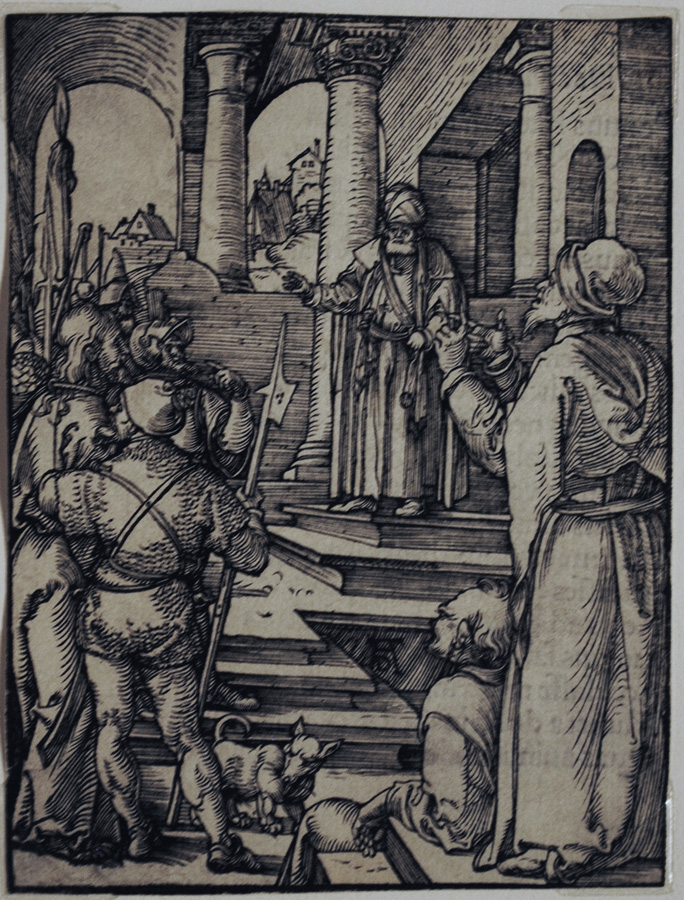 |
|
Jesus taken to Pilate (B. 31, S. 116, Meder 140). Original woodcut, 1508-09. Our impression was published in the 1511 Latin book edition. It is a very good impression with strong contrasts and no sign of wear. It has been trimmed on the border line with part of the border line preserved all around. Strauss observed that "the complicated architecture, the schematic presentation, and especially the disproportionate size of the figures set this sheet apart from most of the others in the series. . . . The gabled structures, in this instance, are more reminiscent of Nuremberg than of Jerusalem" (p. 362). Heller notes that copies of this scene exist by Master GS, Marcantonio Raimondi, Virgil Solis, Mommard, Waesberg, and others. Image size: 128x97mm. Price: Please call or email for current pricing information.
|
|
|
|
|
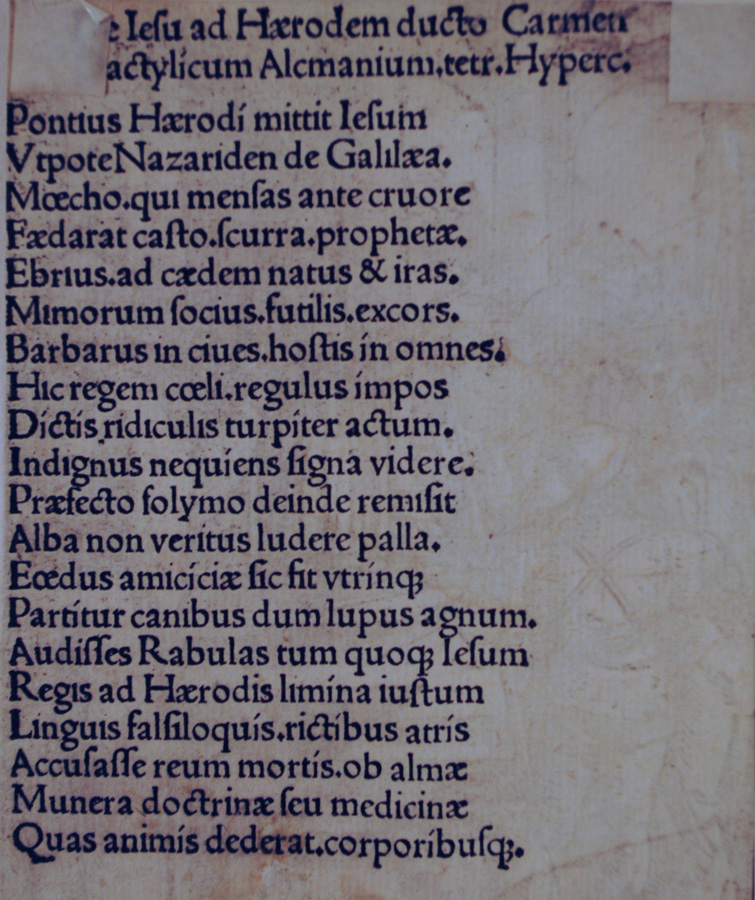 |
|
Jesus taken to Pilate (B. 31, S. 116, Meder 140). Original woodcut, 1508-09. A superb, dark, and well-inked impression from the first 1511 book edition with the Latin text on the verso. From the 1511 first edition of the Small Woodcut Passion with verses on the verso by Benedictus Chelidonius. The text relates to the woodcut that follows the Jesus taken to Pilate, Christ before Herod. The text is only to be found in the 1511 edition of the Small Woodcut Passion.
|
|
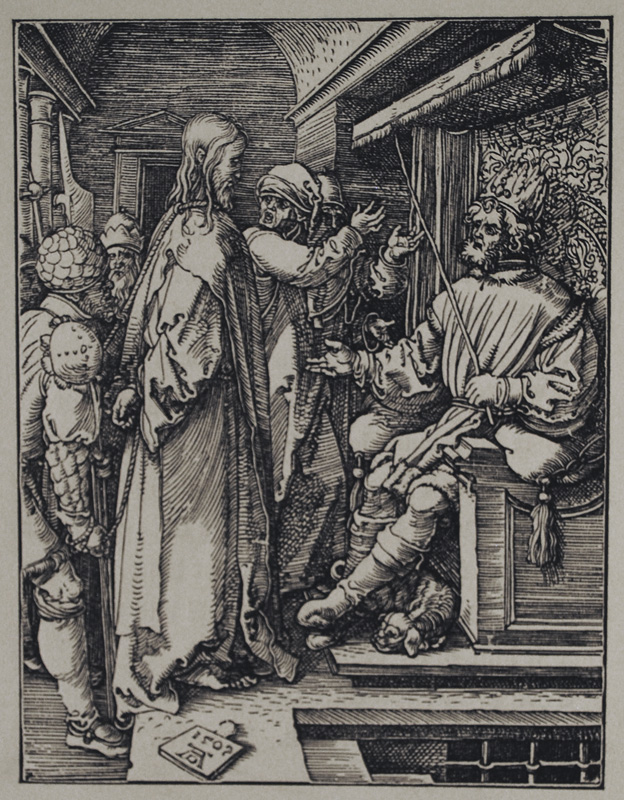 |
|
|
|
Christ before Herod (B. 32, S. 117, M. 141) Original woodcut, dated 1509 in the block for the Small Passion. Upon learning that Chirst came from Galilee, Pilate sends him to Herod, who had jurisdiction over that part of the country. As Luke describes it, "And when Herod saw Jesus he was exceedingly glad; for he had been desious to see him for a long time, because he had heard many things about him, and he hoped to have seen some miracle done by him. Then he questioned him [Jesus] in many words but he [Jesus] answered him nothing." Heller notes that copies of this scene exist by Master GS, Marcantonio Raimondi, Virgil Solis, Mommard, Waesberg, and others. In 1844 plaster casts were made from Dürer's original woodblocks for the Small Woodcut Passion, which had just been acquired by the British Museum. From these casts, metal plates were made and a small edition produced. Our impression is from this edition. Image size: 127x97mm. Price: Please call or email for current pricing information.
|
|
|
|
|
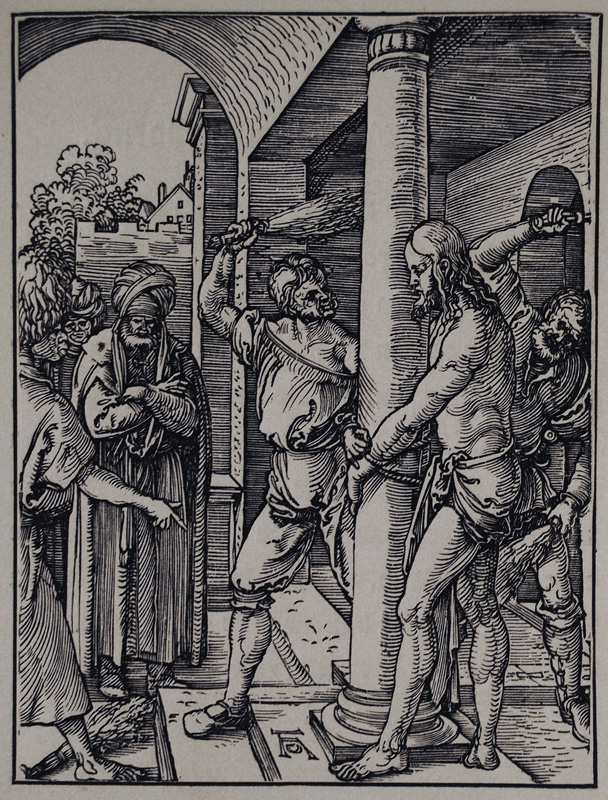 |
|
The Flagellation (B. 33, S. 118, M. 142) Original woodcut, c. 1509 for the Small Passion. Heller notes that copies of this scene exist by Master GS, Marcantonio Raimondi, Virgil Solis, Mommard, Waesberg, and others. In 1844 plaster casts were made from Dürer's original woodblocks for the Small Woodcut Passion, which had just been acquired by the British Museum. From these casts, metal plates were made and a small edition produced. Our impression is from this edition. Image size: 127x97mm. Price: Please call or email for current pricing information.
|
|
|
|
|
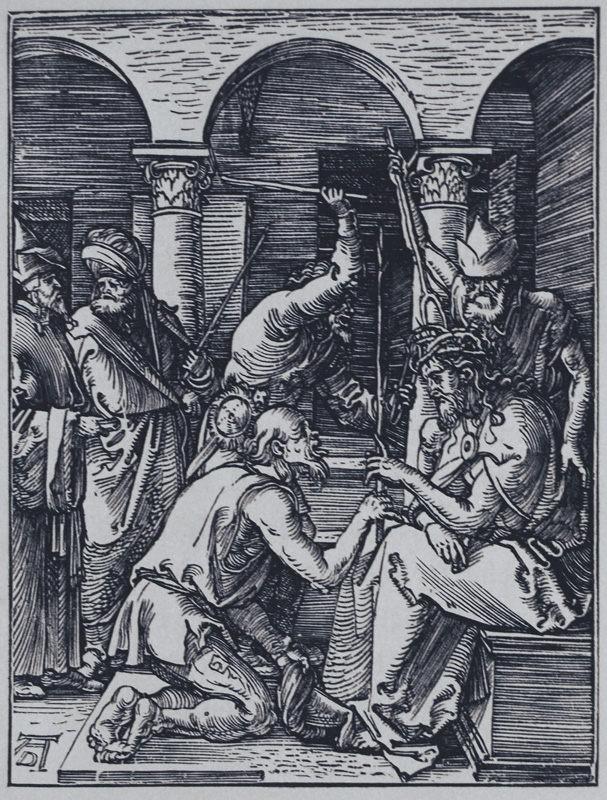 |
|
Christ Crowned with Thorns (B. 34, S. 119, M. 143). Original woodcut, c. 1509 for the Small Passion. Strauss notes that Caiaphas and Herod are observing at left. The man kneeling before Jesus is presenting him with a sapling instead of a scepter, but, as Mathhew observes, from it "another cross may grow" (Matthew 27:29) for the future redemption of man. As Panofsky suggests with reference to the Frontispiece of the Large Passion, "Dürer did not intend to illustrate any specific event in the life of Christ on earth . . . but [it] becomes for us a vision of the eternal Christ Who has completed His Passion on earth and yet continues to be tortured by the sins of mankind" ; the question is how much does this approach play out here as well? Heller notes that copies of this scene exist by Master GS, Marcantonio Raimondi, Virgil Solis, Mommard, Waesberg, and others. In 1844 plaster casts were made from Dürer's original woodblocks for the Small Woodcut Passion, which had just been acquired by the British Museum. From these casts, metal plates were made and a small edition produced. Our impression is from this edition. Image size: 127x97mm. Price: Please call or email for current pricing information.
|
|
|
|
|
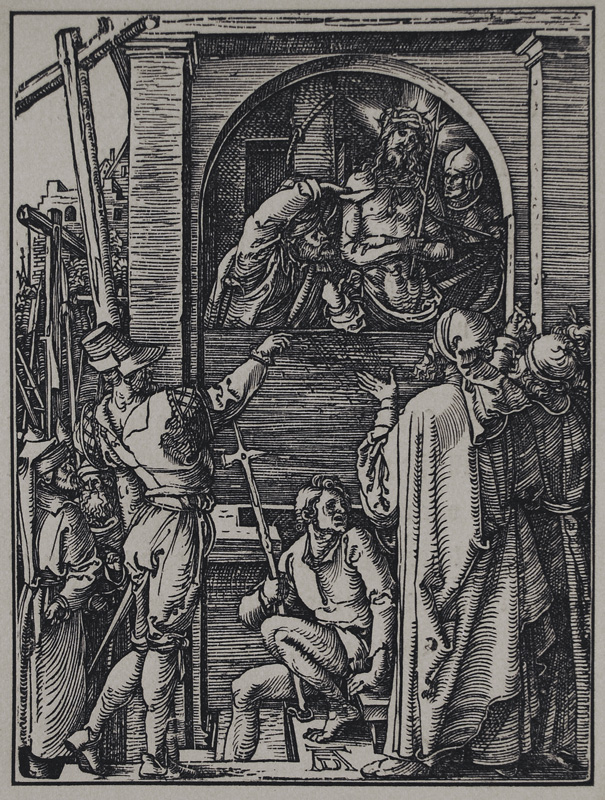 |
|
Ecce Homo / Behold the Man! (B. 35, S. 120, M. 144). Original woodcut, c. 1509 for the Small Passion. Strauss notes that Pilate is lifting Jesus garment in an unsuccesful appeal for compassion from the viewers. Most of the space in this piece is given over to the building in whose window Jesus, Pilate, and a guard stand; to the left, we see the procession to Golgotha already forming with a ladder and two unoccupied crosses visible. Heller notes that copies of this scene exist by Master GS, Marcantonio Raimondi, Lambert Hopfer, Martino Rota, Virgil Solis, Mommard, Waesberg, and others. In 1844 plaster casts were made from Dürer's original woodblocks for the Small Woodcut Passion, which had just been acquired by the British Museum. From these casts, metal plates were made and a small edition produced. Our impression is from this edition. Image size: 127x97mm. Price: Please call or email for current pricing information.
|
|
|
|
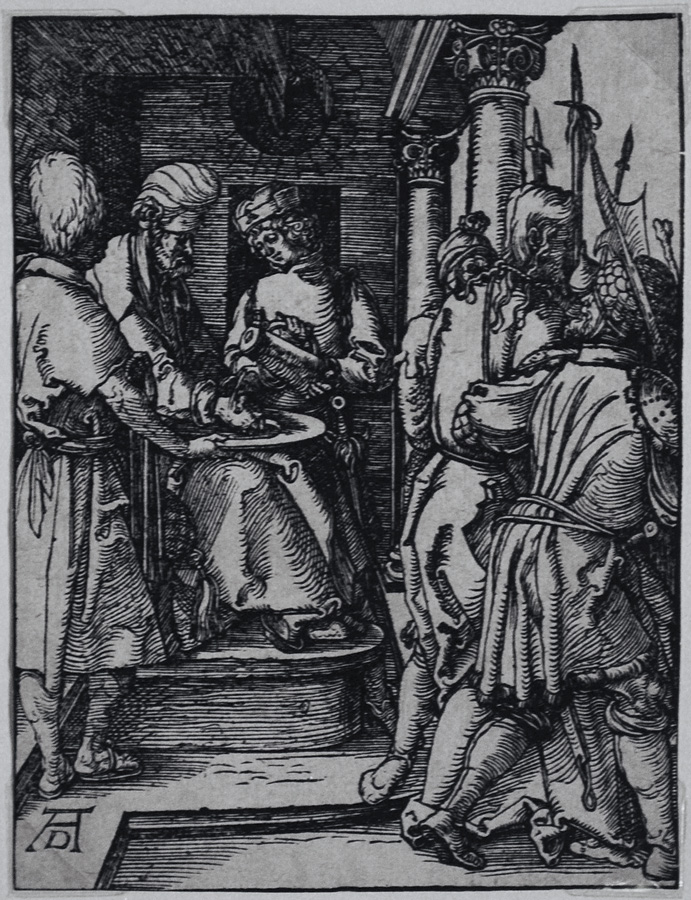 |
|
Pilate wasshing his hands (B. 36, S. 121, M. 145) Original woodcut, c. 1509 for the Small Passion. A very good well-inked proof before the 1511 Latin text edition with borders all around (though slightly trimmed), with strong contrasts and little or no sign of wear. We see two separate actions here: Pilate is washing his hands to signify that he has finished with Jesus; Jesus, his back to Pilate, is being led away to be crucified. Meder describes the proofs before the 1511 edition as "superbly beautiful." The gap in the bottom center seen on impressions of this work in the 1511 Latin text edition has not yet occurred. A very powerful and dramatic piece. Image size: 129x97mm. Price: Please call or email for current pricing information.
|
|
|
|
|
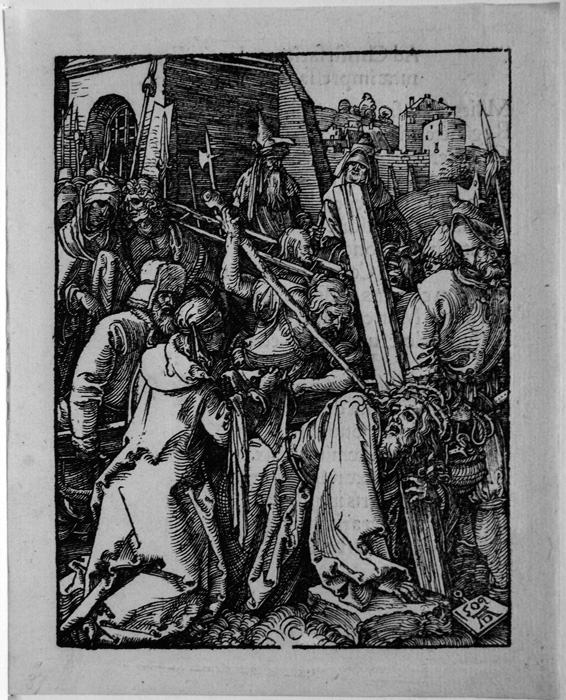 |
|
Christ Carrying the Cross (B. 37, S. 122). Original woodcut, 1509. A brilliant impression from the 1511 first edition with the Latin text on the verso printed on laid paper with an unreadable partial watermark and with wide margins. Strauss says, "Of all Durer's versions of this subject, this is the most remarkable. The emphasis is on the Savior's supporting arm, as if his body was suspended from it. A great effort on his part is required to turn his head, as he looks with an expression of helplessness at Veronica tendering her kerchief. It is no longer the pose of Orpheus, as in the Large Passion (no. 59), nor yet the erect figure, symbolizing the the spiritual relationship between the Son of God, and the believer, of the later engraved version" (p. 374). Signed & dated in the block. Meder's description of this woodcut precisely matches our print: "clear and flawless; a big gap lower center; a split upper right" (Strauss, p. 374). Comparing this impression with the other impression from the 1511 edition shown below, the split at the top right appears to be smaller on this impression, suggesting that it is a slightly earlier impression than the one below. One of the greatest prints of the Renaissance. Image size: 127x96mm. Price: Please call or email for current pricing information.
For the text on the verso, see below.
|
|
|
|
|
|
|
|
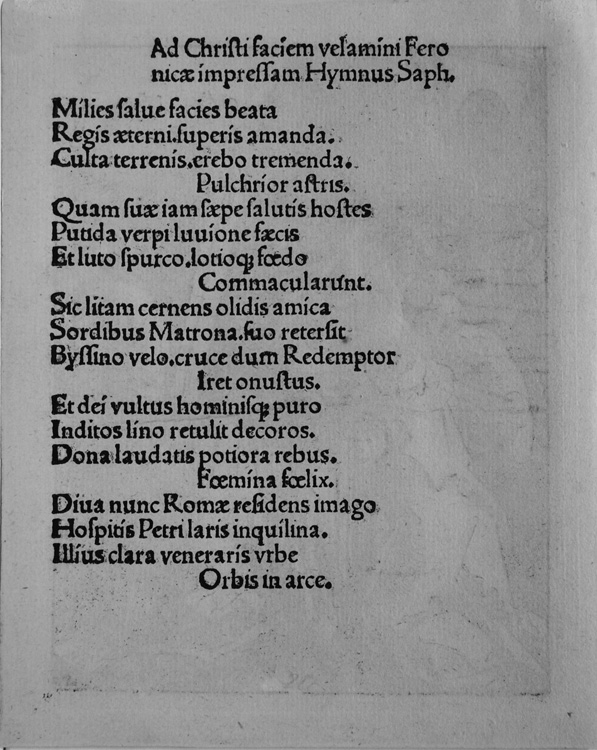 |
|
Christ Carrying the Cross (B. 37, S. 122). Original woodcut, 1509. A brilliant impression from the 1511 first edition with the Latin text on the verso printed on laid paper with an unreadable partial watermark and with wide margins. The text type and layout exactly match those reproduced in the reduced-size facsimile of the 1511 Small Woodcut Passion by Horst Appuhn, Die Kleine Passion von Albrecht Dürer (Dortmund: Harenberg, 1985), p. 52.
|
|
|
|
 |
|
Christ Carrying the Cross (B. 37, S. 122). Original woodcut, 1509. A brilliant impression from the first edition of 1511 with the Latin text verso. Strauss says, "Of all Durer's versions of this subject, this is the most remarkable." Christ turns to St. Veronica, who is offering her kerchief, with a look of helplessness. Signed & dated in the block. One of the greatest prints of the Renaissance. Image size: 127x96mm. Price: SOLD.
|
|
|
|
|
 |
|
Christ Carrying the Cross (B. 37, S. 122). Original woodcut, 1509. In 1844 plaster casts were made from Durer's original woodblocks for the Small Woodcut Passion, which had just been acquired by the British Museum. From these casts, metal plates were made and a small edition produced. Our impression is from this edition. Strauss says, "Of all Durer's versions of this subject, this is the most remarkable." Christ turns to St. Veronica, who is offering her kerchief, with a look of helplessness. On the upper left, St. John helps the Virgin Mary as she follows; an unidentified one of the holy women is behind the Virgin. Signed & dated in the block. One of the greatest prints of the Renaissance. For a very different interpretation, see Durer's woodcut for the Large Passion. See also the commentary upon it in Strauss. Image size: 127x96mm. Price: Please call or email for current pricing information.
|
|
|
|
|
Spaightwood Galleries, Inc.
To purchase, call us at 1-800-809-3343 (1-508-529-2511 in Upton MA & vicinity) or send an email to spaightwood@gmail.com
We accept AmericanExpress, DiscoverCard, MasterCard, and Visa.
We also accept wire transfers and paypal.
For directions and visiting information, please call. We are, of course, always available over the web and by telephone (see above for contact information). Click the following for links to past shows and artists. For a visual tour of the gallery, please click here. For information about Andy Weiner and Sonja Hansard-Weiner, please click here. For a list of special offers currently available, see Specials.
All works are sold with an unconditional guarantee of authenticity (as described in our website listing).
Go back to the top of this page.
Visiting hours: Saturday 10:00 am to 5:00 pm and Sunday noon to 6:00 pm and other times by arrangement.
Please call to confirm your visit. Browsers and guests are welcome.
|
|
|
|
|
|
|
|
|
|
|
|
|
|
|
|
|
|
|
|
|
|
|
|
|
|
|
|
|
|
|
|
|
|
|
|
|













